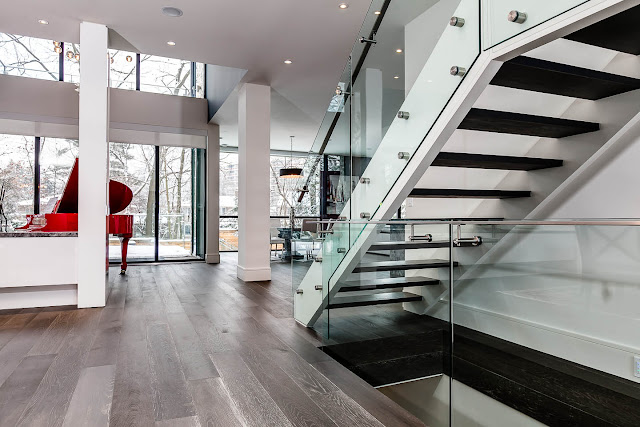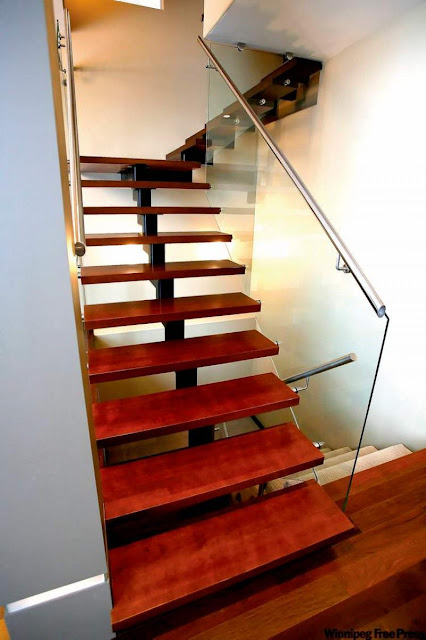Stairs interior with a support structure, railings and steps in laminated and tempered glass. The glass used in the construction of stairs and railings in glass, are built according to the strictest safety standards. We only use tempered glass and stratified , the natural version (float) or extra.
Below I will indicate the features and systems of processing glass that we use for your stairs.
Tempered glass
There are at least three techniques of quenching of the glass , but here we will consider only the most common, namely that thermal :
the sheet, already cut to size and with the edges machined at least a rough edge, is suspended by means of special pliers and introduced in an electrical furnace where it is first heated to a temperature close to the state of softening and then, without any tension, it is then extracted from the oven and cooled abruptly.
Taking place it at a precise temperature called the "glass transition", the outer surface shrinks while the interior, which cools more slowly, is still in the field viscous. When the interior is then also cools and contracts, the outer surface, which is already in the elastic range, is placed in compression from the "heart" which remains in traction.
This particular processing technique induces vitreous sheet in a state of permanent tension, such as to confer the characteristic of greater resistance to both mechanical and thermal shocks and, consequently, to bending.
The tempered glass, when broken, is reduced to minute fragments not sharp.
The resistance of this material to compression and high enough, while tensile strength is more modest and closely linked to the absence of defects.
To give an idea of the improvement of the strength characteristics that the hardening gives, suffice to say that the tensile strength is equal to 4-7 Kg / mm2, in a common glass, while the hardened up to 12-20 Kg / mm2. For both types the compressive strength even reaches 100 Kg / mm2.
Laminated glass
The laminated glass is obtained by coupling together one or more sheets of glass with one or more layers of polyvinyl butyral (PVB ).
The problem more difficult to solve in the realization of these artifacts derives from the remarkable difference between the coefficient of expansion of the glass and that of the polycarbonate which is about 7 times that of the first.
The solution adopted has been the development of a film belonging to the large family chemical-organic of polyurethanes which, interposed, not only joins firmly the glass with the PVB, but also allows to compensate the difference of validly dilation that otherwise could lead to delaminations between the layers.
The polymer used in this case has a special feature called "thermoplastic" that causes a decrease in the modulus of elasticity with increasing temperature that is, in simple words, a gradual softening and content.
I personally think that this is precisely the characteristic that allows compensate for the differences of the coefficients of expansion between glass and PVB. In fact, the manufacturing process is covered by industrial secret so it is not possible to give even a brief description.
In general, however, the laminated are realized through the following steps:
chemical degreasing and washing of the glass sheets, formation of the package with the drafting of the various alternating layers of PVB to the slabs with interposition of the polyurethane film, adhesion of the various layers through the passage in an infrared oven that, by heating the whole at a temperature of 70/80 ° C, causes the expulsion of almost all the air.
Finally the laminate is heated to about 140 ° C and subjected, in an autoclave, to a pressure of 10 bar in order to consolidate the "sandwich" expelling all the residual air between the layers.
At the end of the process, which has a total duration of between 3 and 12 hours, you get a monobloc product.
Friday, September 25, 2015
Subscribe to:
Post Comments (Atom)




0 comments:
Post a Comment